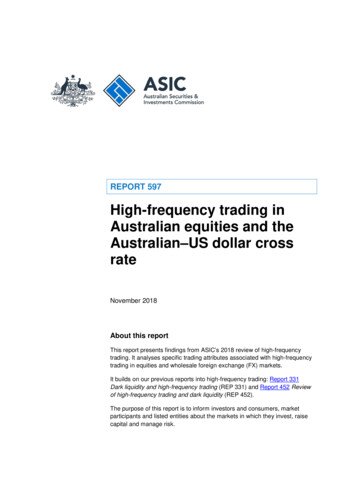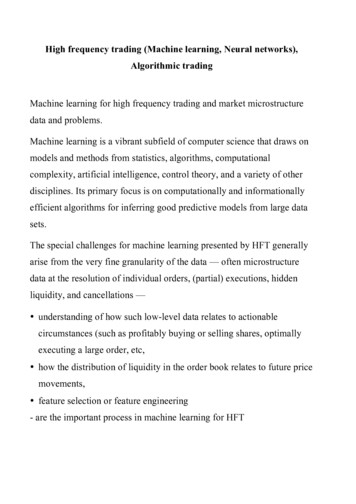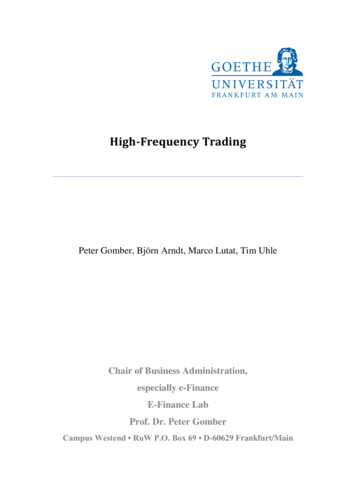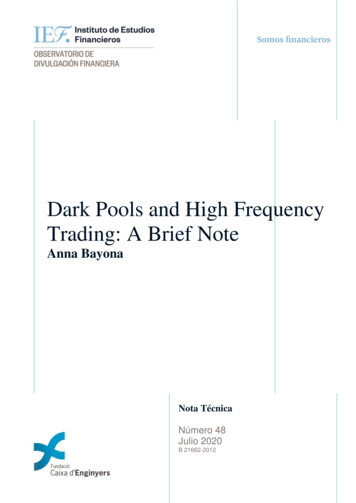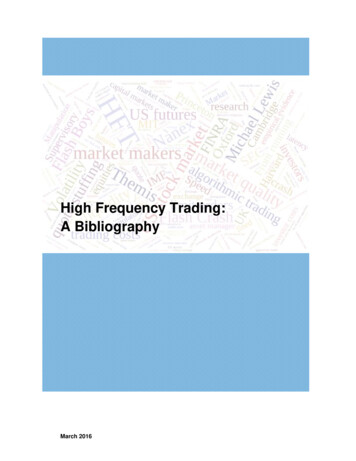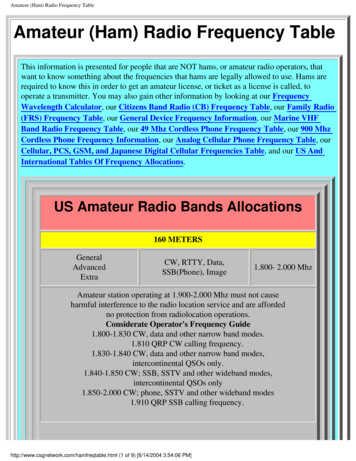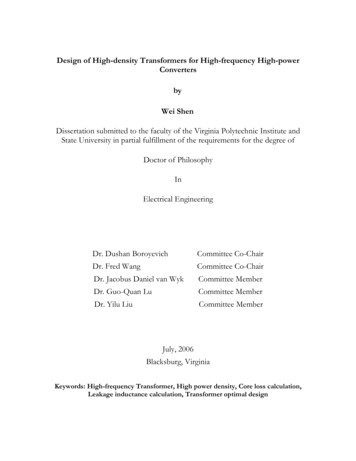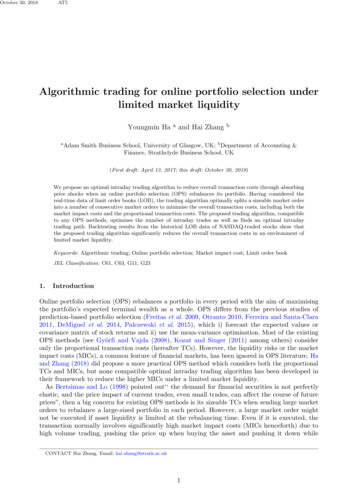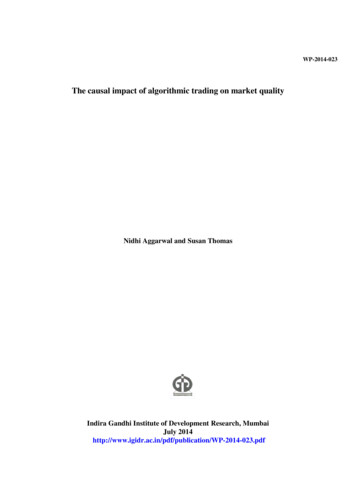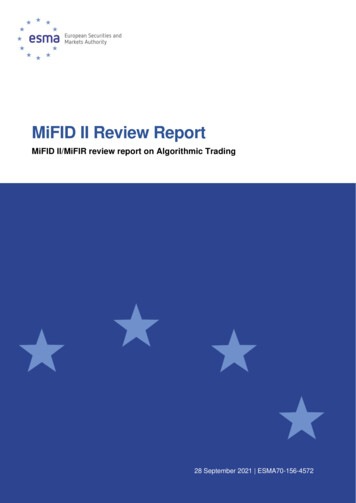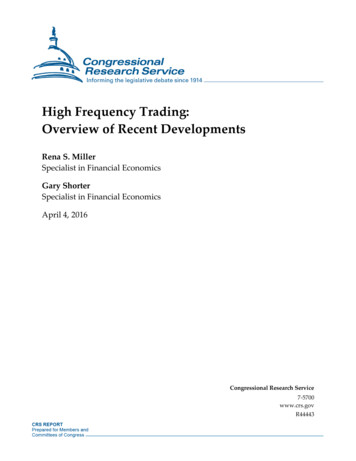
Transcription
High Frequency Trading:Overview of Recent DevelopmentsRena S. MillerSpecialist in Financial EconomicsGary ShorterSpecialist in Financial EconomicsApril 4, 2016Congressional Research Service7-5700www.crs.govR44443
High Frequency Trading: Overview of Recent DevelopmentsSummaryHigh-frequency trading (HFT) generally refers to trading in financial instruments, such assecurities and derivatives, transacted through supercomputers executing trades withinmicroseconds or milliseconds (or, in the technical jargon, with extremely low latency). There is nouniversal or legal definition of HFT, however. Neither the Securities and Exchange Commission(SEC), which oversees securities markets, nor the Commodity Futures Trading Commission(CFTC), which regulates most derivatives trading, have specifically defined the term. By mostaccounts, high frequency trading has grown substantially over the past 10 years: estimates holdthat it accounts for roughly 55% of trading volume in U.S. equity markets and about 40% inEuropean equity markets. Likewise, HFT has grown in futures markets—to roughly 80% offoreign exchange futures volume and two-thirds of both interest rate futures and Treasury 10-yearfutures volumes.The CFTC oversees any HFT, along with other types of trading, in the derivatives markets itregulates. These include futures, swaps and options on commodities, and most financialinstruments or indices, such as interest rates. The SEC oversees HFT and other trading in thesecurities markets and the more limited securities-related derivatives markets which it regulates.In general, traders that employ HFT strategies are attempting to earn small amounts of profit pertrade. Broadly speaking, these strategies can be categorized as passive or aggressive strategies.Passive strategies include arbitrage trading—attempts to profit from price differentials for thesame stocks or their derivatives traded on different trading venues; and passive market making, inwhich profits are generated by spreads between bid and ask prices. Aggressive strategies includethose known as order anticipation or momentum ignition strategies. Various observers, includingSEC staff, have said that these aggressive strategies should be a central focus of public policyconcerns. This may be because such strategies can share some similarities to practices such asfront-running and spoofing, which are generally illegal. In addition, regulators have expressedconcern over whether certain aggressive HFT strategies may be associated with increased marketfragility and volatility, such as that demonstrated in the “Flash Crash” of May 6, 2010; theOctober 15, 2014, extreme volatility in Treasury markets; and the August 24, 2015, market crashin which the Dow Jones Industrial Average fell by more than 1,000 points in early trading.The SEC and CFTC have taken recent steps to bring some HFT under closer scrutiny, boththrough recent regulatory proposals and enforcement actions. The SEC has proposed requiringcertain HFT broker-dealers to register with the Financial Industry Regulatory Authority (FINRA),which oversees broker-dealers. In January 2016, the SEC announced settlements with Barclaysand Credit Suisse totaling more than 150 million, over allegations that Barclays had misled itsinvestors on HFT practices permitted on its private trading platforms known as dark pools, andthat Credit Suisse failed to operate its trading systems as advertised.The CFTC has cracked down on spoofing, using the anti-spoofing authority granted in the DoddFrank Act (P.L. 111-203) in a number of recent enforcement actions involving algorithmictrading. On November 24, 2015, the CFTC released a proposed rule, Regulation AutomatedTrading (Reg AT), governing certain HFT practices. The purpose of Reg AT broadly is to updatethe CFTC’s rules on trading practices in response to the evolution from pit trading to electronictrading. Reg AT mandates risk controls for the exchanges; large financial firms called “clearingmembers” of the exchanges; and firms that trade heavily on the exchanges for their own accounts.The rule also proposes requiring the registration of proprietary traders engaging in algorithmictrading on regulated exchanges through what is called “direct electronic access.”Congressional Research Service
High Frequency Trading: Overview of Recent DevelopmentsAlthough no legislation has been introduced in the 114th Congress directly impacting theregulation or oversight of HFT, several bills have been introduced imposing a tax on a broadarray of financial transactions that could impact HFT. These bills include S. 1371, S. 1373, andH.R. 1464. Congress has also held hearings in the 114th Congress touching on HFT issues as partof its oversight of the SEC and CFTC.This report provides background on various HFT strategies and some associated policy issues,recent regulatory developments and selected enforcement actions by the SEC and CFTC on HFT,and congressional action such as proposed legislation and hearings related to HFT.Congressional Research Service
High Frequency Trading: Overview of Recent DevelopmentsContentsWhat Is High-Frequency Trading? . 1HFT Strategies and Related Policy Issues . 2Selected HFT Strategies . 3Passive HFT Strategies . 3Aggressive HFT Strategies . 5Policy Concerns Regarding Aggressive HFT Strategies . 6Recent CFTC Anti-Spoofing Efforts . 7The CFTC’s “Regulation Automated Trading” . 9FINRA Registration for High-Frequency Securities Traders . 11Recent SEC Enforcement Actions in HFT . 11Congressional Interest . 12Legislative Proposals . 13Hearings: SEC Division Head Outlines Potential Changes in 2016 . 13FiguresFigure 1. Illustration of Spoofing . 9ContactsAuthor Contact Information . 15Congressional Research Service
High Frequency Trading: Overview of Recent DevelopmentsWhat Is High-Frequency Trading?Broadly speaking, high-frequency trading (HFT) is conducted through supercomputers that givefirms the capability to execute trades within microseconds or milliseconds (or, in the technicaljargon, with extremely low latency). In practice, depending on the particulars of the trade, tradingopportunities can last from milliseconds to a few hours.1 This is by contrast to traditional trading,often called pit trading, in which traders would meet at a trading venue called the floor or pit, andcommunicate buy and sell orders via open outcry; and by contrast to slower electronic trading.HFT is a catch-all term used to describe “ultra-fast electronic trading in which participants holdpositions for short periods.”2The term HTF has no universal or legal definition. Neither the Commodity Futures TradingCommission (CFTC) nor the Securities and Exchange Commission (SEC) has issued regulationsdefining it. In a 2012 CFTC Technical Advisory Committee meeting, its Sub-Committee onAutomated and High Frequency Trading, a working group to examine such issues, developed thefollowing loose and nonbinding definition:High frequency trading is a form of automated trading that employs:(a) algorithms for decision making, order initiation, generation, routing, or execution, foreach individual transaction without human direction;(b) low-latency technology that is designed to minimize response times, includingproximity and co-location services;(c) high speed connections to markets for order entry; and(d) high message rates (orders, quotes or cancellations). 3By most accounts, HFT has grown substantially over the past 10 years: it now accounts forroughly 55% of trading volume in U.S. equity markets and about 40% in European equitymarkets.4 In the futures markets, the percentages have also grown markedly. From October 2012to October 2014, the CFTC found that algorithmic trading systems (ATS) were present on at leastone side in nearly 80% of foreign exchange futures trading volume; 67% of interest rate futuresvolume; 62% of equity futures volume; 47% of metals and energy futures volume; and 38% ofagricultural product futures volume.5 ATS has also risen to about 67% of trading in 10-yearTreasury futures and 64% of Eurodollar futures markets.61For detailed background on the growth of high frequency trading (HFT) and related policy concerns, please see CRSReport R43608, High-Frequency Trading: Background, Concerns, and Regulatory Developments, by Gary Shorter andRena S. Miller.2“Electronic Trading, Dutch Fleet,” Economist, April 20, 2013, at h-frequency-heartland-dutch.3CFTC Technical Advisory Committee Sub-Committee on Automated and High Frequency Trading, Working Group 1Presentation (May, 2012) p. 3, at cuments/file/wg1presentation062012.pdf.4Austin Gerig, High-Frequency Trading Synchronizes Prices in Financial Markets, U.S. Securities and ExchangeCommission (SEC), Division of Economic and Risk Analysis (DERA) Working Paper, January 15, 2015, p. 1, pers/dera-wp-hft-synchronizes.html.5Richard Haynes and John S. Roberts,, U.S. Commodity Futures Trading Commission (CFTC), Office of ChiefEconomist, Automated Trading in Futures Markets, March 13, 2015, at lysis/documents/file/oce automatedtrading.pdf.6CFTC, “Remarks of Chairman Timothy Massad before the Conference on the Evolving Structure of the U.S. TreasuryMarket,” October 21, 2015, at amassad-30.Congressional Research Service1
High Frequency Trading: Overview of Recent DevelopmentsIn general, traders that employ HFT strategies are attempting to earn small amounts of profit pertrade. Some arbitrage strategies7 reportedly can earn profits close to 100% of the time. Earlierreports indicated that such strategies might make money on only 51% of the trades, but becausethe trades are transacted hundreds or thousands of times per day, the strategies may still beprofitable.8High-frequency traders employ a diverse range of trading strategies that may also be used incombination with each other. Some analyses broadly categorize these strategies into passive andaggressive trading strategies. Passive strategies involve the provision of limit orders—offersplaced with a brokerage to buy or sell a set number of shares at a specified price or cheaper. Anexample of this is the market making strategy described in the next section. Aggressive strategiesreportedly involve the provision of immediately executable trades such as market orders. Suchstrategies are said to include momentum ignition and order anticipation trading—also known asliquidity detection trading—further discussed in “HFT Strategies and Related Policy Issues,”below.The CFTC oversees any HFT, along with other types of trading, in the derivatives markets itregulates. These include futures, swaps and options on commodities, and most financialinstruments or indices, such as interest rates. The SEC oversees HFT and other trading in thesecurities markets and the more limited securities-related derivatives markets in which itregulates. Although U.S. derivatives markets traditionally relied on human execution of trades,such as through open outcry trading pits, most trading today has moved to highly automatedelectronic systems that generate, transmit, manage, and execute orders through high-speednetworks.Some recent research has observed generally shrinking profits among those who employ HFT dueto factors such as heightened competition. For example, a January 2016 academic study found“that a continuous increase in competition—between high-speed trading algorithms themselvesthrough predatory strategies and from professional human traders adapting and building adequateresponses—has made the business more difficult and has led to shrinking profits for HFT.”9HFT Strategies and Related Policy IssuesMuch more attention has been paid to and written about HFT in an equity market context than inthe futures market context. This section describes several major HFT equity market tradingstrategies. Some evidence, however, exists that these HFT strategies may also be employed infutures markets.10Various observers, including SEC staff, have said that two related types of HFT, dubbedaggressive strategies in contrast to the other passive strategies should be a central focus of public7Arbitrage strategies involve attempts to profit from price differentials for the same stocks or their derivatives (such asstock options) that are traded on different trading venues.8Charles M. Jones, “What Do We Know About High-Frequency Trading?” Columbia Business School, March 20,2013, available at tudy CMJones.pdf.9Jean-Philippe Serbera and Pascal Paumardc, “The Fall of High-Frequency Trading: A Survey of Competition andProfits,” Research in International Business and Finance, January 2016, pp. 271–287, at 027553191530026X.10For example, see Akindynos-Nikolaos Baltas and Robert Koswski, “Trend-following and Momentum Strategies inFutures Markets,” European Financial Management Association (EFMA), December 10, 2011, AL%20MEETINGS/2012-Barcelona/papers/EFMA2012 0485 fullpaper.pdf.Congressional Research Service2
High Frequency Trading: Overview of Recent Developmentspolicy concerns as they “ may present serious problems in today’s market structure—orderanticipation and momentum ignition.”11 Although the SEC did not elaborate on its concerns, thismay be because order anticipation strategies, discussed below, can potentially share somesimilarities with an illegal practice called front-running. Momentum ignition strategies canpotentially share certain similarities with a practice called spoofing, which is also illegal in somemarkets.Selected HFT StrategiesThe major HFT trading strategies described below draws upon the findings in a unique 2014 SECstaff literature research survey on HFT, Equity Market Structure Literature Review Part II: HighFrequency Trading, to provide a sense of the research landscape on HFT’s pros and cons.Going forward, however, the reader should be aware of a caveat in the SEC staff literature surveyon its limitations: “The HFT [research] datasets [used in the literature survey] generally havebeen limited to particular products or markets, and the data time periods now are relativelyoutdated, particularly given the pace of change in trading technology and practices. Accordingly,while the recent economic literature has made great progress in beginning to fill in the picture ofHFT, much of the picture remains unfinished.”12 The following is not an exhaustive description ofHFT strategies, but is meant to highlight several of the main strategies addressed in this report.Passive HFT StrategiesPassive market making is when a firm provides liquidity by matching buyer and seller orders orby buying and selling through its own securities inventories if a market maker cannotimmediately match buyers and sellers. In general, these market makers do so by submitting nonmarketable resting orders (i.e., offers to buy and sell certain amounts of securities at thresholdprices that are not immediately available) that provide liquidity to the marketplace. They profit onthe difference between the bid prices buyers are willing to pay for a security and the ask pricessellers are willing to accept. Some of this kind of HFT market making is reportedly driven by theHFT firm’s receipt of so-called liquidity rebates (usually a fraction of a penny a share) providedby Electronic Communication Networks (ECNs)13 and stock exchanges for the limit orders thatthey post to those trading centers. Some argue that the subsidies help to ensure sustained market11SEC, Concept Release on Equity Market Structure, January 14, 2010, p. 54, at f.12SEC, Staff of the Division of Trading and Markets, Equity Market Structure Literature Review Part II: HighFrequency Trading, March 18, 2014, at https://www.sec.gov/marketstructure/research/hft lit review march 2014.pdf.13An Electronic Communication Network (ECN) is an automated system that matches buy and sell orders forsecurities. It connects major brokerages and individual traders so that they can trade directly between themselveswithout going through a middleman.Congressional Research Service3
High Frequency Trading: Overview of Recent Developmentsparticipation regardless of market conditions.14 The profit-making opportunities for marketmaking HFTs can be enhanced when markets are especially volatile.15The SEC staff analysis found that on average primarily passive HFT strategies appear to have abeneficial impact on various market quality metrics by reducing bid-ask spreads and pricevolatility (significantly changing securities prices) during the trading day.16It can be argued that high-frequency traders generally tend to be better informed than many nonhigh-frequency traders, an attribute that derives from their comparative speed in processingsecurities market data. Moreover, all things being equal, when better-informed traders interactwith less-informed traders, the better-informed traders are apt to buy low and sell high, earningprofits, whereas the less-informed traders are apt to buy high and sell low, generating losses. Thephenomenon is called adverse selection because under this scenario less-informed traders tend tobe disproportionately involved in unattractive trades.17Other cited research in the SEC literature survey found that the entry of a high-frequency traderthat primarily engaged in market making rather inexplicably resulted in a substantial decrease inadverse selection. This is the reverse of the outcome found for aggressive HFT strategiesdescribed in the next section.Arbitrage trading is profiting from price differentials for the same or related securities. Theseprice differences may occur between an exchange-traded fund (ETF) and an underlying basket ofstocks, that are traded on different market centers, such as the London Stock Exchange and theNew York Stock Exchange (NYSE), or the same stock and its derivatives, such as a specific stockand its stock’s options.18 Within this context, various HFT firms also employ something calledslow market arbitrage wherein the firms attempt to arbitrage small price differences for stocksbetween various exchanges resulting from infinitesimal time differences in the trading prices thatthey report on the same securities, a practice described in Flash Boys, the controversial 2014book on HFT by Michael Lewis.1914The rebates are one side of a “maker-taker model” for subsidizing the provision of stock liquidity employed byvarious market centers, such as the New York Stock Exchange, Nasdaq, and the BATS Exchange. In this model,investors and traders that put in limit orders typically receive a small rebate from the exchange upon execution of theirorders because they are regarded as having contributed to liquidity in the stock (i.e., they are liquidity “makers”).Conversely, those that put in market orders are regarded as “takers” of liquidity and charged a modest fee by theexchange for their orders. Although the rebates are typically fractions of a cent per share, they can add up to significantamounts over the millions of shares traded daily by high-frequency traders. Many HFT firms employ trading strategiesspecifically designed to capture as much of the liquidity rebates as possible.15Bradley Hope, “Big Profits For the Speediest Traders Hope,” Wall Street Journal, August 25, 2016, p. C-1.16SEC, Equity Market Structure Literature Review Part II.17For example, see Charles M. Jones, “What Do We Know About High-Frequency Trading?,” Columbia BusinessSchool, March 20, 2013, at tudy CMJones.pdf.18For a detailed example of HFT arbitrage trading, please see Elvis Picardo, “You’d Better Know Your HighFrequency Trading Terminology,” Investopedia, April 25, 2014, at g-terminology.asp. The article provides the followingexample: “assume that a fictitious company named UVW is trading at 20.00/ 20.01 on all exchanges, but because ofsudden large-scale buying on the Nasdaq, jumps to 20.03/ 20.04 on that exchange. HFT firms would use theirsuperior speed to buy large numbers of UVW shares at 20.01 from the other exchanges and sell them a fraction of asecond later at 20.03 on the Nasdaq. This arbitrage would push up the price of UVW on the other exchanges and driveit lower on the Nasdaq exchange, resulting in a new equalized price of, say, 20.02/ 20.03.”19Michael Lewis, Flash Boys, (W. W. Norton & Company, 2015).Congressional Research Service4
High Frequency Trading: Overview of Recent DevelopmentsThe SEC staff survey indicated that the research that it reviewed did not “reveal a great deal aboutthe extent or effect of the HFT arbitrage strategies.”20Aggressive HFT StrategiesMomentum ignition is a strategy in which a proprietary trading firm initiates a series of orders ortrades aimed at causing rapid up or down securities price movements.21 Such traders “may intendthat the rapid submission and cancellation of many orders, along with the execution of sometrades, will spoof22 the algorithms of other traders into action and cause them to buy (or sell) moreaggressively. Or the trader may intend to trigger standing stop loss orders that would helpfacilitate a price decline.”23 As such, by establishing an early position, the high-frequency traderis attempting to profit when it subsequently liquidates the position after it spurs an incrementalprice movement. (Figure 1 below gives a detailed example of spoofing.) However, the linebetween spoofing per se—which the Dodd Frank Act24 made illegal by amending the CommodityExchange Act (CEA)25—and a momentum ignition strategy can be nuanced. Unlike the CEA,federal securities laws do not outlaw spoofing by name, although the SEC has attacked spoofingby characterizing it as a manipulative practice violating antifraud and anti-manipulationprohibitions elsewhere in securities laws.26Order anticipation, also known as liquidity detection trading, involves traders using computeralgorithms to identify large institutional orders that sit in dark pools or other stock order tradingvenues. High-frequency traders may repeatedly submit small-sized exploratory trading ordersintended to detect orders from large institutional investors. The process can provide the highfrequency trader with valuable intelligence on the existence of hidden large investor liquidity,which may enable the trader to trade ahead of the large order under the assumption that the orderwill ultimately move the security’s market pricing to benefit the HFT firm. The line between thisstrategy and front-running, which is not permitted, can be nuanced.Front-running generally means profiting by placing one’s own orders ahead of a large order basedon knowledge of that impending order.27 However, the SEC’s 2010 Concept Release on EquityMarket Structure emphasized that illegal front-running may occur when a firm or person violatesa duty—such as a fiduciary duty—to a large buyer or seller by trading ahead of that firm tobenefit from an expected price movement.28 When such a duty existed, the SEC explained, therewas already a violation. “The type of order anticipation strategy [which the SEC was discussing]involves any means to ascertain the existence of a large buyer (seller) that does not involveviolation of a duty, misappropriation of information, or other misconduct. Examples include the20SEC, Equity Market Structure Literature Review Part II: High Frequency Trading, p. 13.SEC, Concept Release on Equity Market Structure, p. 56.22Italics added for emphasis.23SEC, Concept Release on Equity Market Structure, p. 57.24P.L. 111-203.257 U.S.C.§1 et seq.26Particularly as violations of the Securities Exchange Act §10(b) (15 U.S.C. §78a). For a more detailed examination,see George S. Canellos “Spoofing in the Derivatives and Securities Markets,” Milbank, November 4, 2015, s-Nov2015.pdf.27For a detailed look at an example of a front-running violation in securities markets, please see SEC, “SEC ChargesDallas-Based Trader With Front Running,” press release, May 24, 2013 at elease/1365171574978.28SEC, Concept Release on Equity Market Structure, p. 54.21Congressional Research Service5
High Frequency Trading: Overview of Recent Developmentsemployment of sophisticated pattern recognition software to ascertain from publicly availableinformation the existence of a large buyer (seller), or the sophisticated use of orders to ‘ping’different market centers in an attempt to locate and trade in front of large buyers and sellers.”29 Inother words, the SEC appeared to distinguish high-frequency order anticipation strategies aspossibly distinct from front-running based on front-running involving violation of a duty to thelarge buyer or seller, but still expressed a desire to examine the effects of such order anticipationstrategies further.Policy Concerns Regarding Aggressive HFT StrategiesIn the HFT literature survey, the SEC staff analysis characterized momentum ignition and priceanticipation, the two aggressive HFT strategies, as having both “positive and negative aspects.”30For example, one study found that these aggressive strategies can improve certain aspects of pricediscovery in the short run, whereas another study found that while the positive impact of pricediscovery is significantly higher than that by non-HFT for large-cap stocks, it is inconclusive formid-cap stocks and significantly lower for small-cap stocks. Meanwhile, another study found thatalthough aggressive HFT had a greater effect on price discovery in the short run (up to 10seconds), passive non-high-frequency traders had a consistently higher impact on price discoveryin the long run (up to two minutes). The staff analysis also referenced a study that foundaggressive HFT increases the adverse selection costs that non-high-frequency passive traders aresubject to. The staff analysis noted two studies that collectively found aggressive HFT potentiallyworsened the market trading transaction costs for institutional investors and helped fosterextremely volatile market conditions.The SEC also flagged concerns with such strategies. For instance, in its 2010 Concept Release,the SEC cited research that referred to order anticipators as “parasitic traders” who “profit onlywhen they can prey on other traders. They do not make prices more informative, and they do notmake markets more liquid. Large traders are especially vulnerable to order anticipators.”31 Theagency requested comments and public input on whether such order anticipation strategiessignificantly detract from market quality and harm institutional investors.In addition, regulators have expressed concern over whether certain aggressive HFT strategiesmay be associated with increased market fragility and volatility, such as that demonstrated in the“Flash Crash” of May 6, 2010; August 24, 2015 market crash in which the Dow Jones IndustrialAverage fell by more than 1,000 points in early trading; and October 15, 2014 day of extremevolatility in Treasury markets, among others. In an October 2015 speech analyzing the October14, 2015 Treasury market meltdown, CFTC Chair Timothy Massad noted that CFTC staff hadanalyzed the frequency of “flash” events in Treasury futures and in five of the most active futurescontracts: (1) corn; (2) gold; (3) West Texas Intermediate (WTI) crude oil; (4) E-mini S&Pfutures, which represent an agreement to buy or sell the cash value of an underlying stock index(i.e., the S&P 500) at a specified future date; and (5) the EuroFX, which reflects changes in theU.S. dollar value of the European euro.32 CFTC staff found that, “Movements of a magnitudesimilar to Treasuries on October 15th were not uncommon in many of these contracts. In fact,29SEC, Concept Release on Equity Market Structure, pp. 54-55.SEC, Equity Market Structure Literature Review Part II: High Frequency Trading, p. 15.31SEC, Concept Release on Equity Market Structure, p. 55 citing Larry Harris, Trading and Exchanges: MarketMicrostructure for Practitioners (New York, NY: Oxford University Press, 2003) at 251.32CFTC, “Remarks of Chairman Timothy Massad b
roughly 55% of trading volume in U.S. equity markets and about 40% in European equity markets.4 In the futures markets, the percentages have also grown markedly. From October 2012 to October
